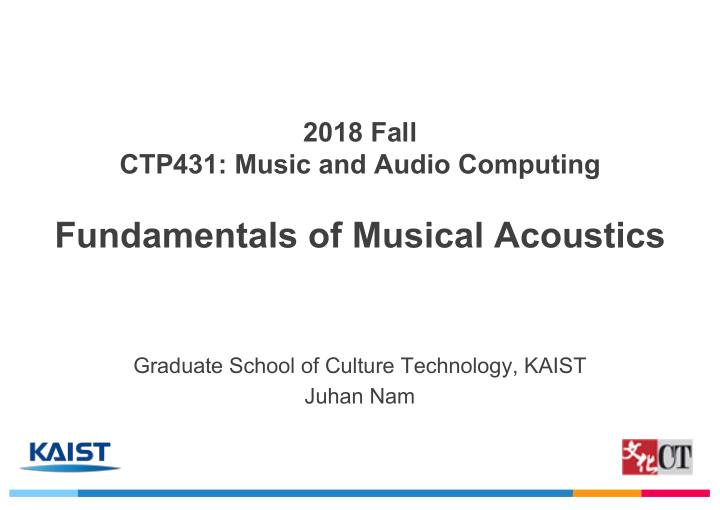



2018 Fall CTP431: Music and Audio Computing Fundamentals of Musical Acoustics Graduate School of Culture Technology, KAIST Juhan Nam
Outlines • Introduction to musical tones • Musical tone generation - String - Pipe, Membrane • Properties of musical tones - Time-domain - Frequency-domain - Time-Frequency domain • Human perception
Introduction to Musical Tones
Taxonomy of Musical Instruments Source: https://jameskennedymonash.wordpress.com/2012/05/06/mind-map-taxonomy-of-musical-instruments/
Musical Tone Generation Excitation (plucking, striking) Source-driven (bowing, blowing) Amplitude Envelope Musical Action Sound Instrument 1D vibration (string, pipe) 2D vibration (bar, drum) Pitch and Spectral Envelope
Musical Tone Generation Excitation (plucking, striking) Newton “Law of motion” Source-driven (bowing, blowing) Musical Action Sound Instrument 1D vibration (string, pipe) Rayleigh “Wave Properties of Sound” 2D vibration (bar, drum)
Musical Tone Generation: String 1. Drive force on a sound object 2. Vibration by restoration force 3. Propagation 4. Reflection 5. Superposition 6. Standing Wave (modes) 7. Radiation
Musical Tone Generation: String • One-dimensional ideal vibrating string (string tension) K c = (linear mass density) ε Wave Equation K ∂ 2 y ∂ x 2 = ε ∂ 2 y ∂ t 2 Boundary Conditions 𝑧 0,0 = 0 𝑧 𝑀, 0 = 0 Fixed or open ends Initial Conditions Action (plucking, striking)
Wave Propagation • Explained by wave equation on the vibrating string K ∂ 2 y ∂ x 2 = ε ∂ 2 y y ( x , t ) = y r ( t − x / c ) + y l ( t + x / c ) ∂ t 2 General solution Any left-traveling wave, any right-traveling wave and the sum of the two satisfy the wave equation. (An example of solutions) 𝑧 𝑦, 𝑢 = 𝐵 ) sin(𝜕𝑢 + 𝑙𝑦) Note that wave is a function of time and position Source: https://www.acs.psu.edu/drussell/Demos/wave-x-t/wave-x-t.html
Wave Reflection • Explained by the boundary conditions Hard Boundary Soft Boundary (wave is flipped) (wave is mirrored) Source: http://www.acs.psu.edu/drussell/Demos/reflect/reflect.html
Wave Superposition and Standing Wave • The sum of two travelling waves in opposite directions with the same frequency cancel or reinforce each other, creating a stationary oscillation Source: http://www.acs.psu.edu/drussell/Demos/superposition/superposition.html
Complex Harmonic Oscillation • Combination of modes are determined by the initial conditions (including the string length) Modes Wave Motion Source: https://www.acs.psu.edu/drussell/Demos/string/Fixed.html
Video https://www.youtube.com/watch?v=_X72on6CSL0
Musical Tone Generation: Pipe • Analogous to ideal 1D string - Woodwind or brass instrument: flute, clarinet, trumpet - Blowing: continuous excitation - Longitudinal pressure wave to travel in air column Source: https://www.acs.psu.edu/drussell/Demos/StandingWaves/StandingWaves.html
Musical Tone Generation: Membrane • 2D wave equation: 𝑧 𝑦, 𝑧, 𝑢 - Drum, percussion - Boundary condition: by the shape of membrane - Circular harmonic oscillation à generate inharmonic tones (0,1) Mode (1,1) Mode (2,1) Mode (0,2) Mode Source: https://www.acs.psu.edu/drussell/Demos/MembraneCircle/Circle.html
Properties of Musical Tones Amplitude envelope • Time domain - Intensity (dynamics) - Amplitude envelope (ADSR) • Frequency domain Spectrum (inharmonic) - Pitch (fundamental frequency) - Spectral envelope (formant) - Harmonicity: ratio between tonal and noise - Inharmonicity Spectrogram • Time-Frequency domain - Temporal changes of spectral envelope
Sound Generation and Perception Generation Propagation Perception Sensation of the air vibration Traveling via the air Vibration on instruments through ears Psychological Physical
Sound Perception • human auditory system - Ears (physiological sense) and brain (cognitive sense) • Ears - A series of highly sensitive transducers - Three parts - Outer, middle and inner ears Electric - Transform sound into sub-band signals Air Fluid (Cook, 1999) Mechanical • Brain - Segregate and organize the auditory stimulus - Recognize loudness, pitch and timbre
Outer Ear • Pinnae - Collect sounds: http://www.douglas-self.com/MUSEUM/COMMS/ear/ear.htm - Related to recognize the sound direction (spatial sound) - Head-related transfer function (HRTF) • Auditory canal - Protect ear drums - Quarter-wave resonance: boost the vibration around 3kHz by 15-20 dB • Ear drum - Membrane that transduces air vibration to mechanical vibration - Malleus (hammer) is attached to it
Middle Ear • Ossicles - malleus (hammer), incus (anvil) and stapes(stirrup) - The smallest bones in human body - Impedance matching: between air pressure (outer) and fluid (inner) - Without ossicles, only about 1/30 of the sound energy would have been transferred to inner ears - Amplification - Work as a lever: membrane size changes from the large (ear drum) to the small (oval windows) • Muscles - Reduce the sound transmission in response to loud sounds
Inner ears Basilar • Cochlea Membrane - Transduces fluid vibration to nerve firing High freq. Low freq. • Basilar membrane - Fluctuate at different positions selectively Source: http://acousticslab.org/psychoacoustics/PMFiles/Module03a.htm according to the frequency of incoming vibration - Similar to a bank of band-pass filters • Organ of Corti - One row of inner hair-cell: fire neural spikes - Three rows of outer hair-cell: gain control
Auditory Transduction http://www.youtube.com/watch?v=PeTriGTENoc
References • UNSW Music Acoustics Website - http://newt.phys.unsw.edu.au/music/ • Stanford Music150 (by Tom Rossing) - https://ccrma.stanford.edu/courses/150/ • The Science of Sound (3rd Edition) - Thomas D. Rossing, F. Richard Moore, and Paul A. Wheeler
Recommend
More recommend